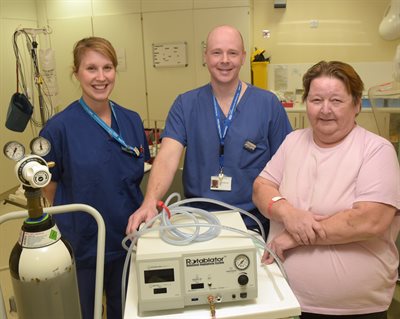Heart centre introduces drill treatment

Patient Beverley Blundell (right), our first patient to receive rotablation treatment, pictured with consultant cardiologist Dr David Sharman and cardiac nurse Hayley Hill
Patients in Northamptonshire with severely blocked arteries that cannot be treated with routine surgery are now getting specialist treatment closer to home.
Patients receiving treatment in our heart centre can now benefit from a complex surgical procedure, called rotablation, which uses high-speed drills to blast away hardened calcium.
Dr David Sharman, consultant cardiologist said: "Most cardiac patients who have blocked arteries are able to have a routine coronary intervention, which means using a needle to go into the body and place a balloon into the narrowed artery to squeeze it open before placing a stent across the narrowing to keep it wide open.
"But a small number of patients cannot be treated with this routine approach as they have a high build-up of calcium that prevents balloon expansion and stent placement.
"Previously our patients would have had to either travel to Oxford or Harefield hospital for the procedure. It’s great news for our patients and their families that we can now provide this service here in Northampton."
Rotablation uses a tiny drill to target the hard calcium rather than the soft lining of the blood vessels. It powers through the calcium and then makes it possible to complete the procedure using conventional techniques with balloons and stents.
Factfile
- Coronary Rotational Atherectomy (‘rotablation’) is a small burr (1.25-2mm diameter) that is used through percutaneously via a small tube through the radial artery or femoral artery under local anaesthetic.
- It is used for severe calcified coronary lesions, sometimes avoiding bypass surgery or treating patients that would previously been untreatable due to the severity of disease.
- The burr rotates at 170,000 rpm and has a diamond dust coated tip to drill through the coronary lesions. This enables passage and deployment of coronary stents.
- The procedure takes around an hour and can be done under local anaesthetic.
- Coronary artery disease is the biggest killer in the UK, and a major cause of chronic illness. A narrowed artery in the body raises your risk of stroke, while a narrowed artery in the heart causes pain (angina) and heart attack.
Posted on Thursday 10th August 2017